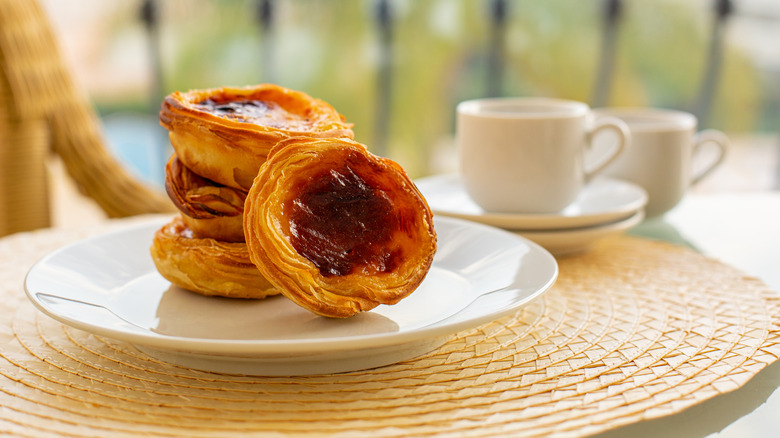What Is A Portuguese Egg Tart And What Does It Taste Like?
The term "egg tart" likely conjures thoughts of Chinese cuisine, but did you know that the wildly popular Chinese egg tart actually has European origins? If you are a fan of this decadent, bite-sized dessert, you need to try the Portuguese dish that inspired it: pastel de nata. The pastel de nata (plural: pastéis de nata) is a custard tart famous throughout Portugal, particularly in the capital city of Lisbon, where it has been made for over 300 years. In addition to being beloved throughout the country, the tart has even inspired copycats around the world in places with sizeable Portuguese immigrant populations, such as Macau's jagra de ovos.
Pastel de nata translates to English as "cream pastry," a perfect description of the dish's luscious texture. It consists of a flaky pastry shell filled with an eggy custard, and it is typically flavored with cinnamon, which makes it distinct from other varieties of custard tart served around the world. Pastel de nata has been declared by many to be the most famous dessert in Portugal, and it's hard to argue against that assessment, given the dish's cultural imprint.
The history of pastel de nata
Pastéis de nata have a history as rich as their custard filling, dating back over three centuries to the historic Jerónimos Monastery in the Belém district of Lisbon. The monks of Jerónimos would use egg whites to starch their laundry, giving them a surplus of egg yolks, purportedly leading to the invention of these custard tarts. Eventually, the monks began successfully selling the pastries to earn money for the monastery, that is, until their entire world collapsed.
The country's religious orders dissolved at the end of the Portuguese Civil War in 1834, and monasteries closed. Jerónimos monks were expelled, but this episode would prove just the beginning of the Pastel de nata story. A Brazilian businessman named Domingo Rafael Alves bought the recipe from one of the monastery's former bakers. In 1837, he opened Antiga Confeitaria de Belém (Old Confectionery of Belém) and began selling pastéis de nata to the masses.
Antiga Confeitaria de Belém is still in business today, and it has become so popular that many people simply refer to it as "pastéis de Belém," the same name the bakery has given to its unique version of Portuguese egg tarts. It's just a few minutes' walk from the Jerónimos Monastery, which is now a UNESCO World Heritage Site and tourist attraction. They make, on average, 20,000 pastéis every day, and the line is always down the block.
The proper elements of a pastel de nata
Antiga Confeitaria de Belém's recipe is a closely guarded secret, but you can make great pastéis de nata at home with a few essential ingredients. The tricky part is mastering Pastéis de nata's crisp and flaky pastry dough. To obtain the proper texture, you must roll the dough very thin and spread it with butter. Then, roll it into a tight log and slice it into segments. Each segment is pressed into a paper-thin disk of dough with a spiral of butter running through it, which gives it a rich, flaky quality like the outermost layer of a croissant. Once complete, the pastry crusts are nestled in a muffin tin to await their filling.
The filling is a standard custard (custard is like pudding but with eggs), and it's important to note that it only uses milk, not cream. The milk is mixed with flour, egg yolks, and cinnamon-infused sugar syrup before being poured into the cupped pastry shells. Now, baking pastéis de nata in a home oven can be a bit tricky. In professional settings, such as the bakery at Antiga Confeitaria de Belém, these desserts are baked at incredibly high temperatures, approaching 800 F. To make this work at home, crank your oven up as high as possible (probably 500-550 F) and make the pastéis in a small muffin tin, as large pastries won't crisp up quickly enough in a home setting.


